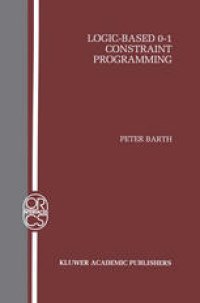
Ebook: Logic-Based 0–1 Constraint Programming
Author: Peter Barth (auth.)
- Tags: Operations Research/Decision Theory, Artificial Intelligence (incl. Robotics), Optimization
- Series: Operations Research/Computer Science Interfaces Series 5
- Year: 1996
- Publisher: Springer US
- Edition: 1
- Language: English
- pdf
A logic view of 0-1 integer programming problems, providing new insights into the structure of problems that can lead the researcher to more effective solution techniques depending on the problem class. Operations research techniques are integrated into a logic programming environment. The first monographic treatment that begins to unify these two methodological approaches.
Logic-based methods for modelling and solving combinatorial problems have recently started to play a significant role in both theory and practice. The application of logic to combinatorial problems has a dual aspect. On one hand, constraint logic programming allows one to declaratively model combinatorial problems over an appropriate constraint domain, the problems then being solved by a corresponding constraint solver. Besides being a high-level declarative interface to the constraint solver, the logic programming language allows one also to implement those subproblems that cannot be naturally expressed with constraints. On the other hand, logic-based methods can be used as a constraint solving technique within a constraint solver for combinatorial problems modelled as 0-1 integer programs.
A logic view of 0-1 integer programming problems, providing new insights into the structure of problems that can lead the researcher to more effective solution techniques depending on the problem class. Operations research techniques are integrated into a logic programming environment. The first monographic treatment that begins to unify these two methodological approaches.
Logic-based methods for modelling and solving combinatorial problems have recently started to play a significant role in both theory and practice. The application of logic to combinatorial problems has a dual aspect. On one hand, constraint logic programming allows one to declaratively model combinatorial problems over an appropriate constraint domain, the problems then being solved by a corresponding constraint solver. Besides being a high-level declarative interface to the constraint solver, the logic programming language allows one also to implement those subproblems that cannot be naturally expressed with constraints. On the other hand, logic-based methods can be used as a constraint solving technique within a constraint solver for combinatorial problems modelled as 0-1 integer programs.
A logic view of 0-1 integer programming problems, providing new insights into the structure of problems that can lead the researcher to more effective solution techniques depending on the problem class. Operations research techniques are integrated into a logic programming environment. The first monographic treatment that begins to unify these two methodological approaches.
Logic-based methods for modelling and solving combinatorial problems have recently started to play a significant role in both theory and practice. The application of logic to combinatorial problems has a dual aspect. On one hand, constraint logic programming allows one to declaratively model combinatorial problems over an appropriate constraint domain, the problems then being solved by a corresponding constraint solver. Besides being a high-level declarative interface to the constraint solver, the logic programming language allows one also to implement those subproblems that cannot be naturally expressed with constraints. On the other hand, logic-based methods can be used as a constraint solving technique within a constraint solver for combinatorial problems modelled as 0-1 integer programs.
Content:
Front Matter....Pages i-xiv
Introduction....Pages 1-8
Constraint Logic Programming....Pages 9-44
Pseudo-Boolean Constraints....Pages 45-73
A Logic Cut Based Constraint Solver....Pages 75-79
Pseudo-Boolean Unit Resolution....Pages 81-97
Logic Cuts and Enumeration....Pages 99-107
Linear Pseudo-Boolean Inequalities and Extended Clauses....Pages 109-162
Simplification....Pages 163-204
Linearization....Pages 205-218
Projection....Pages 219-227
Conclusion....Pages 229-232
Back Matter....Pages 233-253
A logic view of 0-1 integer programming problems, providing new insights into the structure of problems that can lead the researcher to more effective solution techniques depending on the problem class. Operations research techniques are integrated into a logic programming environment. The first monographic treatment that begins to unify these two methodological approaches.
Logic-based methods for modelling and solving combinatorial problems have recently started to play a significant role in both theory and practice. The application of logic to combinatorial problems has a dual aspect. On one hand, constraint logic programming allows one to declaratively model combinatorial problems over an appropriate constraint domain, the problems then being solved by a corresponding constraint solver. Besides being a high-level declarative interface to the constraint solver, the logic programming language allows one also to implement those subproblems that cannot be naturally expressed with constraints. On the other hand, logic-based methods can be used as a constraint solving technique within a constraint solver for combinatorial problems modelled as 0-1 integer programs.
Content:
Front Matter....Pages i-xiv
Introduction....Pages 1-8
Constraint Logic Programming....Pages 9-44
Pseudo-Boolean Constraints....Pages 45-73
A Logic Cut Based Constraint Solver....Pages 75-79
Pseudo-Boolean Unit Resolution....Pages 81-97
Logic Cuts and Enumeration....Pages 99-107
Linear Pseudo-Boolean Inequalities and Extended Clauses....Pages 109-162
Simplification....Pages 163-204
Linearization....Pages 205-218
Projection....Pages 219-227
Conclusion....Pages 229-232
Back Matter....Pages 233-253
....